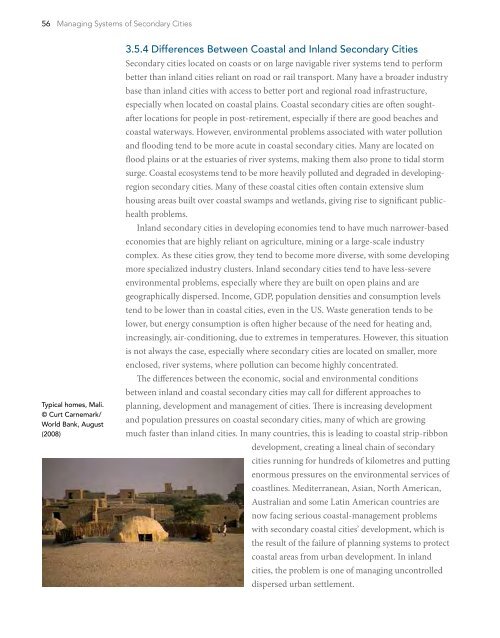DYhWN
DYhWN
DYhWN
Create successful ePaper yourself
Turn your PDF publications into a flip-book with our unique Google optimized e-Paper software.
56 Managing Systems of Secondary CitiesTypical homes, Mali.© Curt Carnemark/World Bank, August(2008)3.5.4 Differences Between Coastal and Inland Secondary CitiesSecondary cities located on coasts or on large navigable river systems tend to performbetter than inland cities reliant on road or rail transport. Many have a broader industrybase than inland cities with access to better port and regional road infrastructure,especially when located on coastal plains. Coastal secondary cities are often soughtafterlocations for people in post-retirement, especially if there are good beaches andcoastal waterways. However, environmental problems associated with water pollutionand flooding tend to be more acute in coastal secondary cities. Many are located onflood plains or at the estuaries of river systems, making them also prone to tidal stormsurge. Coastal ecosystems tend to be more heavily polluted and degraded in developingregionsecondary cities. Many of these coastal cities often contain extensive slumhousing areas built over coastal swamps and wetlands, giving rise to significant publichealthproblems.Inland secondary cities in developing economies tend to have much narrower-basedeconomies that are highly reliant on agriculture, mining or a large-scale industrycomplex. As these cities grow, they tend to become more diverse, with some developingmore specialized industry clusters. Inland secondary cities tend to have less-severeenvironmental problems, especially where they are built on open plains and aregeographically dispersed. Income, GDP, population densities and consumption levelstend to be lower than in coastal cities, even in the US. Waste generation tends to belower, but energy consumption is often higher because of the need for heating and,increasingly, air-conditioning, due to extremes in temperatures. However, this situationis not always the case, especially where secondary cities are located on smaller, moreenclosed, river systems, where pollution can become highly concentrated.The differences between the economic, social and environmental conditionsbetween inland and coastal secondary cities may call for different approaches toplanning, development and management of cities. There is increasing developmentand population pressures on coastal secondary cities, many of which are growingmuch faster than inland cities. In many countries, this is leading to coastal strip-ribbondevelopment, creating a lineal chain of secondarycities running for hundreds of kilometres and puttingenormous pressures on the environmental services ofcoastlines. Mediterranean, Asian, North American,Australian and some Latin American countries arenow facing serious coastal-management problemswith secondary coastal cities’ development, which isthe result of the failure of planning systems to protectcoastal areas from urban development. In inlandcities, the problem is one of managing uncontrolleddispersed urban settlement.


